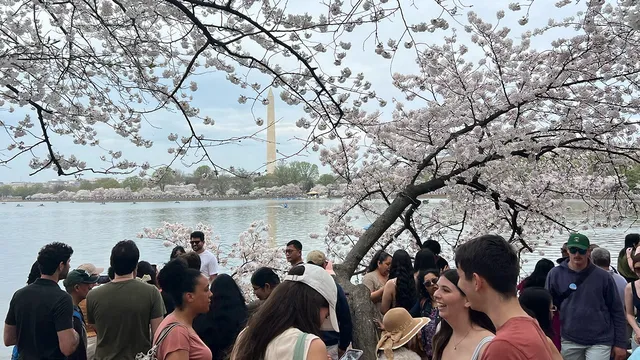
Washington, D.C. welcomes thousands to witness cherry blossoms in full bloom
2025-03-29 19:19- In spring, Washington, D.C. celebrates the blooming of over 3,000 cherry trees, creating a vibrant and festive atmosphere.
- The Tidal Basin attracts numerous locals and tourists who engage in activities such as taking photographs and enjoying picnics.
- This annual event emphasizes cultural appreciation and community connections celebrated through various local dining and social experiences.
Express your sentiment!
Insights
In Washington, D.C., spring brings over 3,000 cherry trees ready to bloom, creating a vibrant scene for both residents and tourists. Recently, a sunny day saw many people flocking to the Tidal Basin to experience the beauty of the blossoms ahead of their predicted peak bloom. Visitors participated in various activities, documenting the picturesque landscape with photographs amidst the seasonal decorations and lively atmosphere. Families were seen enjoying picnics, posing for ceremonial photos, and soaking in the nature around the iconic monuments in the area. The cherry blossom celebration also encouraged local bars and restaurants to promote special themed menus and events. These efforts to embrace the season highlight the cultural significance of the cherry trees, originally a gift from Japan, and showcase the unity and joy found in the appreciation of nature in the nation's capital. The scene at the Tidal Basin reflects a mix of tradition and celebration, serving as a reminder of the beauty of spring each year. Locals and visitors alike find joy in participating in various activities in the park, from casual strolls to well-thought-out photoshoots marking important milestones. With various establishments offering cherry blossom specials, the local culinary scene thrives during this period, contributing to the overall festive spirit. The combination of natural beauty, historical context, and social activities allows the cherry blossom season to become a key event in Washington, D.C's annual calendar. As more people gather to celebrate the cherry blossom season, the significance of the cherry trees as a cultural symbol grows more evident. Conversations among visitors often share excitement about the blooming trees and highlights of their personal experiences associated with the festival, reinforcing community bonds. Experts note that such gatherings offer an insight into how nature can foster connection among diverse populations. Moving forward, festivals around the cherry blossoms may evolve, yet the enduring appeal of the trees continues to captivate the imaginations of many, sustaining a rhythm of life in the city that embodies gratitude for nature's transient beauty. Ultimately, these cherry blossoms serve as more than just a spring phenomenon; they symbolize a celebration of life, renewal, and community within the nation's capital. As families and friends come together to admire this breathtaking spectacle, they create lasting memories that will resonate through their lives. This seasonal event cements the notion that nature has the power to bring joy and unity, making it one of the most cherished times of the year in Washington, D.C.
Contexts
Cherry blossoms, or sakura, hold a significant cultural importance in the United States, primarily stemming from their historical, aesthetic, and symbolic value. The most notable event associated with cherry blossoms in the U.S. is the National Cherry Blossom Festival, which commemorates the gift of cherry trees from Japan to Washington, D.C., in 1912. This gift was a gesture of friendship and has since become a symbol of the long-standing relationship between the United States and Japan. The festival, which attracts millions of visitors each spring, not only celebrates the beauty of these blooms but also serves as a platform for cultural exchange, showcasing Japanese arts, crafts, and performances alongside American traditions. As such, the cherry blossoms have evolved into an emblem of solidarity and cooperation between the two nations. The aesthetic appeal of cherry blossoms also plays a vital role in their cultural significance in the U.S. With their ephemeral beauty, the blossoms attract visitors who come to witness the stunning pink and white blooms against the backdrop of monuments and memorials in Washington, D.C. Photographers, nature enthusiasts, and families gather to enjoy the spectacle, rendering the cherry blossoms a cherished part of American springtime. The blossoms’ short-lived nature—typically lasting just a week or two—conveys deeper themes of transience and the fleeting nature of life, a concept that resonates with many and encourages appreciation for the moment. Beyond their aesthetic value, cherry blossoms symbolize renewal and hope. During the festival, various events emphasize themes of rebirth and rejuvenation as people emerge from the winter months. This symbolism can be particularly poignant in a diverse society where individuals may seek common ground and shared experiences. The festival fosters community engagement and understanding, creating a sense of belonging among people of different backgrounds. Moreover, the cherry blossoms are often utilized in art, literature, and educational programs, making them a vital part of the cultural landscape in the U.S. The lasting impact of cherry blossoms extends beyond the festival, as they have inspired various traditions within American culture. Schools and local communities often hold their own cherry blossom celebrations, incorporating educational activities about their significance and Japanese culture. The trees have also been planted in cities across the nation, further embedding them into the American landscape. As the cherry blossoms continue to bloom every spring, they serve as a reminder of the beauty of cultural exchange and the enduring friendships that blossom over time.